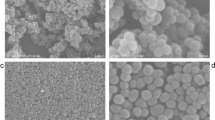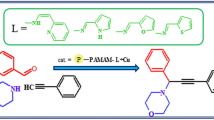Abstract
Fibrous poly(styrene-b-glycidylmethacrylate) brushes were grafted on poly(styrene–divinylbenzene) (P(S–DVB)) beads using surface-initiated atom transfer radical polymerization. Tetraethyldiethylenetriamine (TEDETA) ligand was incorporated on P(GMA) block. The ligand attached beads were used for reversible immobilization of lipase. The influences of pH, ionic strength, and initial lipase concentration on the immobilization capacities of the beads have been investigated. Lipase adsorption capacity of the beads was about 78.1 mg/g beads at pH 6.0. The K m value for immobilized lipase was about 2.1-fold higher than that of free enzyme. The thermal, and storage stability of the immobilized lipase also was increased compared to the native lipase. It was observed that the same support enzyme could be repeatedly used for immobilization of lipase after regeneration without significant loss in adsorption capacity or enzyme activity. A lipase from Mucor miehei immobilized on styrene–divinylbenzene copolymer was used to catalyze the direct esterification of butyl alcohol and butyric acid.











Similar content being viewed by others
References
Gaur R, Gupta GN, Vamsikrishnan M, Khare SK (2008) Protein-coated microcrystals of Pseudomonas aeruginosa PseA lipase. Appl Biochem Biotechnol 151:160–166
Raghavendra T, Sayania D, Madamwar D (2010) Synthesis of the ‘green apple ester’ ethyl valerate in organic solvents by Candida rugosa lipase immobilized in MBGs in organic solvents: effects of immobilization and reaction parameters. J Mol Catal B Enzym 63:31–38
Dwiarti L, Ali E, Park EY (2010) Enhancement of lipase catalyzed-fatty acid methyl esters production from waste activated bleaching earth by nullification of lipase inhibitors. Bioresour Technol 101:14–20
Karagoz B, Bayramoglu G, Altintas B, Bicak N, Arica MY (2010) Poly(glycidyl methacrylate)–polystyrene diblocks copolymer grafted nanocomposite microspheres from surface-initiated atom transfer radical polymerization for lipase immobilization: application in flavor ester synthesis. Ind Eng Chem Res 49:9655–9665
Bayramoglu G, Altintas B, Arica MY (2011) Reversible immobilization of uricase on conductive polyaniline brushes grafted on polyacrylonitrile film. Bioprocess Biosyst Eng (in press)
Torres S, Baigori MD, Swathy SL, Pandey A, Castro GR (2009) Enzymatic synthesis of banana flavour (isoamyl acetate) by Bacillus licheniformis S-86 esterase. Food Res Int 42:454–460
Serri NA, Kamaruddin AH, Long WS (2006) Studies of reaction parameters on synthesis of Citronellyl laurate ester via immobilized Candida rugosa lipase in organic media. Bioprocess Biosyst Eng 29:253–260
Yang J, Ma X, Zhang Z, Chen B, Li S, Wang G (2010) Lipase immobilized by modification-coupled and adsorption–cross-linking methods: a comparative study. Biotechnol Adv 28:644–650
Milasinovic N, Milosavljevic N, Filipovic J, Knezevic-Jugovic Z, Krusic MK (2010) Synthesis, characterization and application of poly(N-isopropylacrylamide-co-itaconic acid) hydrogels as supports for lipase immobilization. React Funct Polym 70:807–814
Bayramoglu G, Kacar Y, Arica MY (2002) Covalent immobilization of lipase onto hydophobic group incorporated poly(hydroxyethyl-methacrylate) based membrane matrix. J Food Eng 52:367–374
Arica MY, Soydogan H, Bayramoglu G (2010) Reversible immobilization of Candida rugosa lipase on fibrous polymer grafted and sulfonated p(HEMA/EGDMA) beads. Bioprocess Biosyst Eng 33:227–236
Bayramoglu G, Senel AU, Yilmaz M, Arica MY (2008) Preparation of nanofibrous polymer grafted magnetic poly(GMA-MMA)-g-MAA beads for immobilization of trypsin via adsorption. Biochem Eng J 40:262–274
Arica MY, Bayramoglu G (2006) Invertase reversibly immobilized onto polyethylenimine-grafted poly(GMA-MMA) beads for sucrose hydrolysis. J Mol Catal B Enzym 38:131–138
Arica MY, Bayramoglu G (2004) Reversible immobilization of tyrosinase onto polyethyleneimine-grafted and Cu(II) chelated poly(HEMA-co-GMA) reactive membranes. J Mol Catal B Enzym 27:255–265
Bayramoglu G, Arica MY (2010) Reversible immobilization of lipase on fibrous polymer grafted and metal chelated chitosan membrane. J Mol Catal B Enzym 62:297–304
Yavuz E, Bayramoglu G, Senkal BF, Arica MY (2009) Poly(glycidylmethacrylate) brushes generated on poly(VBC) beads by SI-ATRP technique: hydrazine and amino groups functionalized for invertase adsorption and purification. J Chromatogr B 877:1479–1486
Costa L, Brissos V, Lemos F, Ribeiro RF, Cabral JMS (2009) Enhancing the thermal stability of lipases through mutagenesis and immobilization on zeolites. Bioprocess Biosyst Eng 32:53–61
Li Y, Gao F, Wei W, Qu J-B, Ma G-H, Zhou W-Q (2010) Pore size of macroporous polystyrene microspheres affects lipase immobilization. J Mol Catal B Enzym 66:182–189
Acar MH, Bicak N (2003) Synthesis of hexylated triethylenetetramine. A new ligand for homogeneous atom transfer radical polymerization. J Polym Sci A Polym Chem 41:1677–1680
Cullen SP, Liu XS, Mandel IC, Himpsel FJ, Gopalan P (2008) Polymeric brushes as functional templates for immobilizing ribonuclease A: study of binding kinetics and activity. Langmuir 24:913–920
Sun L, Dai JH, Baker GL, Bruening ML (2006) High-capacity, protein-binding membranes based on polymer brushes grown in porous substrates. Chem Mater 18:4033–4039
Bicak N, Gazi M, Galli G, Chiellini E (2006) Polystyrene microspheres having epoxy functional dangling chains linked by hydrolytically stable bonds via ATRP. J Polym Sci A Polym Chem 44:6708–6716
Jain P, Vyas MK, Geiger JH, Baker GL, Bruening ML (2010) Protein purification with polymeric affinity membranes containing functionalized poly(acid) brushes. Biomacromolecules 11:1019–1026
Bradford MM (1976) A rapid and sensitive method for the quantitation of microgram quantities of protein utilizing the principle of protein–dye binding. Anal Biochem 72:248–254
Furniss BH, Hannaford AJ, Rogers V, Smith PWG, Tatchell AR (eds) (1978) Vogel’s textbook of practical organic chemistry, 4th edn. Longman Inc, New York, p 287
Johansson BL, Belew M, Eriksson S, Glad G, Lind O, Maloisel JL, Norrman N (2003) Preparation and characterization of prototypes for multi-modal separation media aimed for capture of negatively charged biomolecules at high salt conditions. J Chromatogr A 1016:21–33
Chang Y-K, Chou S-Y, Liu J-L, Tasi J-C (2007) Characterization of BSA adsorption on mixed mode adsorbent I. Equilibrium study in a well-agitated contactor. Biochem Eng J 35:56–65
Yang T, Malmquist G, Johansson B-L, Maloisel J-L, Cramer S (2007) Evaluation of multi-modal high salt binding ion exchange materials. J Chromatogr A 1157:171–177
Yavuz E, Bayramoglu G, Senkal BF, Arica MY (2009) Poly(vinylbenzylchloride) beads grafted with polymer brushes carrying hydrazine ligand for reversible enzyme immobilization. J Appl Polym Sci 113:2661–2669
Garcia-Diego C, Cuellar J (2008) Preparation and characterization of a dye–ligand adsorbent for lysozyme adsorption. Chem Eng J 143:337–348
Bayramoglu G, Yilmaz M, Arica MY (2010) Reversible immobilization of laccase to poly(4-vinylpyridine) grafted and Cu(II) chelated magnetic beads: biodegradation of reactive dyes. Bioresour Technol 101:6615–6621
Arıca MY, Bayramoglu G (2004) Polyethyleneimine grafted poly(hydroxyethyl methacrylate-co-glycidyl methacrylate) membranes for glucose oxidase immobilization. Biochem Eng J 20:73–77
Bayramoglu G, Yalın E, Arıca MY (2005) Immobilization of urease via adsorption onto l-histidine-Ni(II) complexed poly(HEMA-MAH) microspheres: preparation and characterization. Process Biochem 40:3505–3513
Arica MY (2000) Immobilization of polyphenol oxidase on carboxymethylcellulose hydrogel beads: preparation and characterization. Polym Int 49:775–781
Arica MY, Tunalı Y, Bayramoglu G (2007) Immobilization of β-galactosidase onto magnetic poly(GMA–MMA) beads for hydrolysis of lactose in bed reactor. Catal Commun 8:1094–1101
Bayramoglu G, Arica MY (2008) Enzymatic removal of phenol and p-chlorophenol in enzyme reactor: horseradish peroxidase immobilized on magnetic beads. J Hazard Mater 156:148–155
Kartal F, Akkaya A, Kilinc A (2009) Immobilization of porcine pancreatic lipase on glycidyl methacrylate grafted poly vinyl alcohol. J Mol Catal B 57:55–61
de Oliveira PC, Alves GM, de Castro HF (2000) Immobilisation studies and catalytic properties of microbial lipase onto styrene–divinylbenzene copolymer. Biochem Eng J 5:63–71
Ozmen EY, Sezgin M, Yilmaz M (2009) Synthesis and characterization of cyclodextrin-based polymers as a support for immobilization of Candida rugosa lipase. J Mol Catal B 57:109–114
Dandavate V, Keharia H, Madamwar D (2009) Ethyl isovalerate synthesis using Candida rugosa lipase immobilized on silica nanoparticles prepared in nonionic reverse micelles. Process Biochem 44:349–352
Pires-Cabral P, da Fonseca MMR, Ferreira-Dias S (2010) Esterification activity and operational stability of Candida rugosa lipase immobilized in polyurethane foams in the production of ethyl butyrate. Biochem Eng J 48:246–252
Bayramoglu G, Hazer B, Altıntas B, Arica MY (2011) Covalent immobilization of lipase onto amine functionalized polypropylene membrane and its application in green apple flavor (ethyl valerate) synthesis. Process Biochem 46:372–378
Kumari A, Mahapatra P, Kumar GV, Banerjee R (2008) Comparative study of thermostability and ester synthesis ability of free and immobilized lipases on cross linked silica gel. Bioprocess Biosyst Eng 31:291–298
Santos JC, de Castro HF (2006) Optimization of lipase-catalysed synthesis of butyl butyrate using a factorial design. World J Microbiol Biotechnol 22:1007–1011
Su G-D, Huang D-F, Han S-Y, Zheng S-P, Lin Y (2010) Display of Candida antarctica lipase B on Pichia pastoris and its application to flavor ester synthesis. Appl Microbiol Biotechnol 86:1493–1501
Author information
Authors and Affiliations
Corresponding authors
Rights and permissions
About this article
Cite this article
Bayramoglu, G., Karagoz, B., Altintas, B. et al. Poly(styrene–divinylbenzene) beads surface functionalized with di-block polymer grafting and multi-modal ligand attachment: performance of reversibly immobilized lipase in ester synthesis. Bioprocess Biosyst Eng 34, 735–746 (2011). https://doi.org/10.1007/s00449-011-0523-1
Received:
Accepted:
Published:
Issue Date:
DOI: https://doi.org/10.1007/s00449-011-0523-1




